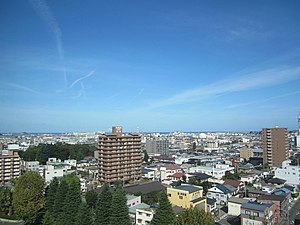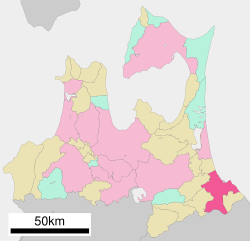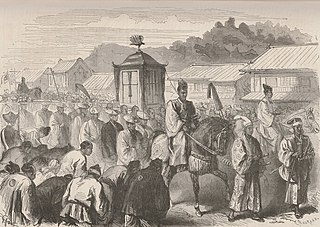
Ninohe is a city located in Iwate Prefecture, Japan. As of 28 February 2017, the city had an estimated population of 27,947, and a population density of 66.47 persons per km2 in 11,865 households. The total area of the city is 420.42 square kilometres (162.33 sq mi).

Hachinohe Station is a railway station operated by the East Japan Railway Company in Hachinohe, Aomori, Japan.

The Aoimori Railway Line is a railway line in Japan. It connects Metoki Station in the town of Sannohe to Aomori Station in Aomori Prefecture.

Sannohe is a town located in located in Aomori Prefecture, Japan. As of 1 October 2016, the town had an estimated population of 9,884, and a population density of 65.1 persons per km2. The total area of the town is 151.79 square kilometres (58.61 sq mi).

Gonohe is a town located in Aomori Prefecture, Japan. As of 31 December 2016, the town had an estimated population of 21,139, and a population density of 119 persons per km2 in 6,905 households. The total area of the town is 177.67 square kilometres (68.60 sq mi).

Nanbu is a town located in Aomori Prefecture, Japan. As of 1 March 2017, the town had an estimated population of 18,906, and a population density of 123 persons per km2 in 7482 households. The total area of the town is 153.12 square kilometres (59.12 sq mi).

Sannohe Station is a railway station on the Aoimori Railway Line in the town of Nanbu, Aomori Prefecture, Japan, operated by the third sector railway operator Aoimori Railway Company.

Asahi Broadcasting Aomori Co., Ltd., also known as ABA, is a Japanese broadcast network affiliated with the ANN. It broadcasts to Aomori Prefecture from studio facilities located in Aomori City.
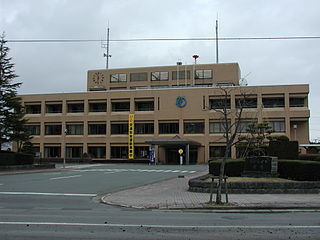
Oirase is a town located in Aomori Prefecture, Japan. As of 1 February 2017, the town had an estimated population of 25,377, and a population density of 353 persons per km², in 10,110 households. The total area of the town is 71.96 square kilometres (27.78 sq mi).

Hachinohe Domain was a tozama feudal domain of Edo period Japan It is located in Mutsu Province, in northern Honshū. The domain was centered at Hachinohe Castle, located in the center of what is now the city of Hachinohe in Aomori Prefecture.

Tanesashi-Kaigan Station is a railway station on the Hachinohe Line operated by East Japan Railway Company in the city of Hachinohe, Aomori Prefecture, Japan.

Hachinohe Sansha Taisai (八戸三社大祭) is a Japanese festival celebrated from July 31 to August 4 in Hachinohe, Aomori Prefecture, Japan. Its rites center on three Shinto shrines: Ogami (霊神社), Shinra (新羅神社), and Shinmei (神明宮) shrines. There is a procession of twenty-seven floats and three mikoshi are also borne through the streets. It has a two hundred and ninety-year history and in 2004 was designated an Important Intangible Folk Cultural Property.
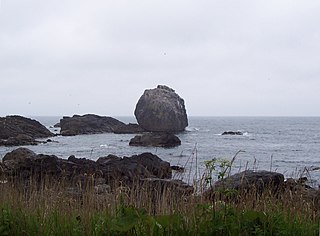
The Tanesashi Coast is section of the coastline of the Pacific Ocean located in the southern portion of the city of Hachinohe, Aomori Prefecture, in the Tōhoku region of northern Japan. It is extends for 12 kilometres (7.5 mi) from the island of Kabushima south towards the city of Kuji in Iwate Prefecture. The coastline includes both sandy and rocky beaches, but is for the most part an elevated coastal terrace noted for its grassy meadows and scenic views.

Ne Castle is a Muromachi period Motte-and-bailey-style Japanese castle located in what is now the city of Hachinohe, Aomori Prefecture, in the Tōhoku region of far northern Japan. It is protected by the central government as a National Historic Site. It was extensively reconstructed in 1994.

Shōjojidate Castle was a Muromachi period Japanese castle located in what is now the town of Nanbu, in Sannohe District of Aomori Prefecture, in the Tōhoku region of far northern Japan. It was also known as the Moto-Sannohe Castle. It was located at a strategic junction of the Ōshū Kaidō with the Kakuno Kaidō and the Mabechi River.

Korekawa Site is a Jōmon period archaeological site in the city of Hachinohe, Aomori Prefecture, in the Tōhoku region of northern Japan. The remains were designated a National Historic Site of Japan in 1957 by the Japanese government. It is also referred to as the Korekawa Stone Age site, although the remains discovered are from the Jōmon period, rather than the Japanese Paleolithic period.

The Hachinohe-Kuji Expressway is an incompleted expressway in the southeastern part of Aomori Prefecture and the coastal area of Iwate Prefecture in northern Japan. It is owned and operated primarily by the Ministry of Land, Infrastructure, Transport and Tourism (MLIT), but has a section maintained by the East Nippon Expressway Company. The route is signed as an auxiliary route of National Route 45 as well E45 under MLIT's "2016 Proposal for Realization of Expressway Numbering."
